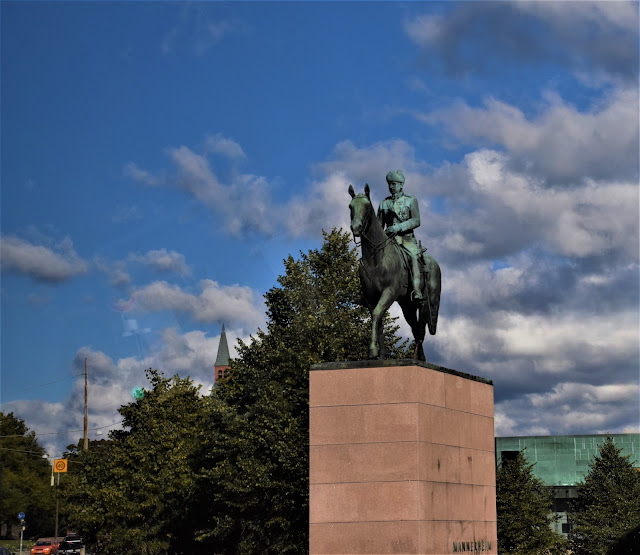This morning we arrived in Helsinki, Finland.
MY EXCURSION: BEST OF HELSINKI & PORVOO
Today I took a Princess excursion which showed us the best of Helsinki and also a visit to a quaint town called Porvoo.
A city of the sea, Helsinki was built along a series of oddly shaped peninsulas and islands jutting into the Baltic coast along the Gulf of Finland. Streets and avenues curve around bays, bridges reach to nearby islands, and ferries ply among offshore islands.
Having grown dramatically since World War II, Helsinki now absorbs more than one-tenth of the Finnish population. The metro area covers 764 square km (474 square miles) and 315 islands. Most sights, hotels, and restaurants cluster on one peninsula, forming a compact central hub. The greater Helsinki metropolitan area, which includes Espoo and Vantaa, has a total population of more than a million people.
Helsinki is a relatively young city compared with other European capitals. In the 16th century, King Gustav Vasa of Sweden decided to woo trade from the Estonian city of Tallinn and thus challenge the Hanseatic League's monopoly on Baltic trade. Accordingly, he commanded the people of four Finnish towns to pack up their belongings and relocate to the rapids on the River Vantaa. The new town, founded on June 12, 1550, was named Helsinki.
For three centuries, Helsinki (Helsingfors in Swedish) had its ups and downs as a trading town. Turku, to the west, remained Finland's capital and intellectual center. However, Helsinki's fortunes improved when Finland fell under Russian rule as an autonomous grand duchy. Czar Alexander I wanted Finland's political center closer to Russia and, in 1812, selected Helsinki as the new capital. Shortly afterward, Turku suffered a disastrous fire, forcing the university to move to Helsinki. The town's future was secure.
Having grown dramatically since World War II, Helsinki now absorbs more than one-tenth of the Finnish population. The metro area covers 764 square km (474 square miles) and 315 islands. Most sights, hotels, and restaurants cluster on one peninsula, forming a compact central hub. The greater Helsinki metropolitan area, which includes Espoo and Vantaa, has a total population of more than a million people.
Helsinki is a relatively young city compared with other European capitals. In the 16th century, King Gustav Vasa of Sweden decided to woo trade from the Estonian city of Tallinn and thus challenge the Hanseatic League's monopoly on Baltic trade. Accordingly, he commanded the people of four Finnish towns to pack up their belongings and relocate to the rapids on the River Vantaa. The new town, founded on June 12, 1550, was named Helsinki.
For three centuries, Helsinki (Helsingfors in Swedish) had its ups and downs as a trading town. Turku, to the west, remained Finland's capital and intellectual center. However, Helsinki's fortunes improved when Finland fell under Russian rule as an autonomous grand duchy. Czar Alexander I wanted Finland's political center closer to Russia and, in 1812, selected Helsinki as the new capital. Shortly afterward, Turku suffered a disastrous fire, forcing the university to move to Helsinki. The town's future was secure.
Just before the czar's proclamation, a fire destroyed many of Helsinki's traditional wooden structures, precipitating the construction of new buildings suitable for a nation's capital. The German-born architect Carl Ludvig Engel was commissioned to rebuild the city, and as a result, Helsinki has some of the purest neoclassical architecture in the world. Add to this foundation the influence of Stockholm and St. Petersburg with the local inspiration of 20th-century Finnish design, and the result is a European capital city that is as architecturally eye-catching as it is distinct from other Scandinavian capitals. You are bound to discover endless engaging details—a grimacing gargoyle; a foursome of males supporting a balcony's weight on their shoulders; a building painted in striking colors with contrasting flowers in the windows. The city's 400 or so parks make it particularly inviting in summer.
Today, Helsinki is still a meeting point of eastern and western Europe, which is reflected in its cosmopolitan image, the influx of Russians and Estonians, and generally multilingual population. Outdoor summer bars ("terrassit" as the locals call them) and cafés in the city center are perfect for people watching on a summer afternoon.
A drive through this remarkable capital reveals a broad spectrum of stunning architecture. Golden onion domes top the mighty red-brick edifice of Usperski Cathedral--the largest Orthodox church in Western Europe. The white walls of the 1,300-seat Opera House soar majestically, and the smooth asymmetry of Finlandia Hall defines Alvar Aalto's architectural masterpiece. In the center of the city lies Market Square, a huge marketplace selling traditional foods and crafts.
Temppeliaukio Church (Rock Church) Helsinki's most important architectural site is carved straight into a solid bed of rock. The huge oval structure is lit in part by skylights that punctuate the rock walls, and it features a roof formed from a dome lined with copper and supported by concrete beams. Inside the church, rough rock lines the walls with an Ice Age crevice serving as the altarpiece. Benches hewn from birch and local mauve, and red and gray granite accents grace the interior.
Porvoo
Finland's second oldest city, founded in 1346, is steeped in the past. Porvoo's red riverside warehouses were painted in the late 18th century in honor of King Gustav III's arrival, and graceful Porvoo Cathedral took its present form at the end of the 15th century. A guided walk of the city's historic old quarter along a network of cobbled streets lined with colorful old buildings, curio shops, cafés and museums gives you ample opportunity to experience Porvoo's rich history.
We had a fabulous candlelight lunch at an old distllery, great atmosphere.
Returned to the shp for a late afternon nap, dinner and a quiet evening. Tomorrow we are in Taillin, Estonia.












.JPG)
.JPG)
.JPG)
.JPG)
.JPG)
.JPG)
.JPG)
.JPG)
.JPG)
.JPG)
.JPG)

.JPG)
.JPG)
.JPG)
Amazing pictures
ReplyDeleteThanks!
Delete